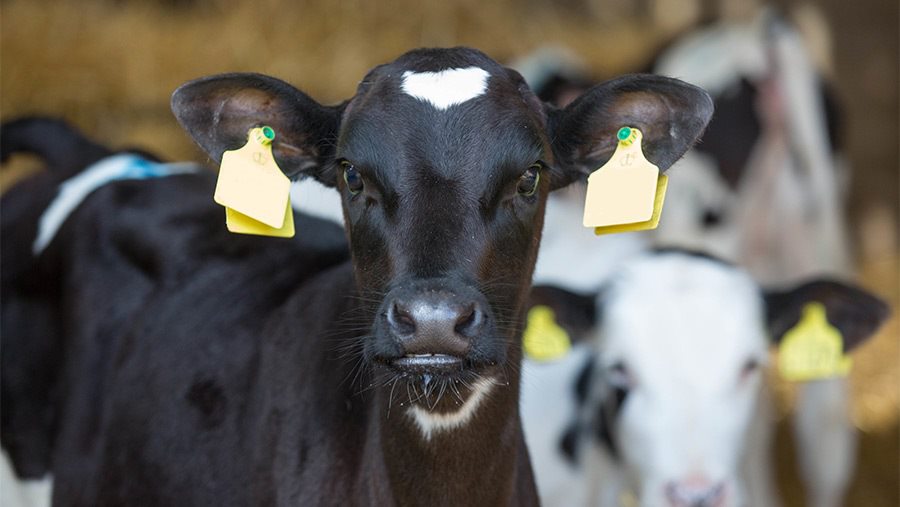How scanning can detect early pneumonia in calves
 © Tim Scrivener
© Tim Scrivener Subclinical pneumonia, where there are no obvious signs of the disease, in young calves is going undetected on farms, a Scottish study has found.
Calves are more likely to succumb to disease during this period due to antibody levels from their dams waning and stressful events such as dehorning or mixing groups.
Vet Jimmy More from the Galloway Vet Group in south Scotland carried out thoracic ultrasound scanning (TUS) of lungs of calves aged four to six weeks to investigate the impact of early life pneumonia.
See also: Q&A: Pneumonia in calves and how to combat it
Subclinical pneumonia in numbers
- 23-67% – The percentage of calves that can be subclinical and are ‘invisible’ to the naked eye
- 202g – Reduction in weight gain per day of beef calves with subclinical lung damage from birth to slaughter
- 509 litres – The reduction in yield in first lactation caused by lung lesions in the first week of life
- 66% – Percentage of calves affected by pneumonia at less than six weeks of age, according to MSD Animal Health’s latest National Youngstock Survey of more than 300 farmers
How scanning works
TUS uses high-frequency sound waves to capture live images of internal body organs. A standard scanner was used in the trial – the same one used for rectal fertility scanning in cows.
Calf hair was soaked in liquid to allow the ultrasound to move through it and the probe was lined up with the ribs to allow inspection of the left and right lungs.
Why use thoracic ultrasound scanning?
TUS is relatively new in the UK but is commonly used in the US. It can be used:
- To scan heifers pre-service so those with lung damage can be sold/finished
- When calves arrive on units so those with lung lesions can be segregated and treated
- As a tool to reduce blanket treatments of antibiotics
- To identify animals for diagnostic sampling in a pneumonia outbreak
- To pinpoint the worst facilities on farm/periods of peak incidence to help improve management.
The trial and the results
Six dairy farms took part in the trial and 193 calf lungs were scanned last spring.
Results showed nine times more calves were affected with subclinical pneumonia than those detected with clinical disease.
Recommendations were made for improvements using MSD Animal Health’s Calf Health Checklist. These included things such as improving nutrition, cleaning and disinfection, monitoring daily liveweight gains, increasing bedding to improve nesting and creating isolation pens for sick calves.
The herds were revisited in the summer and a further 171 calves were scanned. The improvements led to a reduction in subclinical disease – it dropped to six times that of clinical cases.
Farms administering early-life vaccinations had lower lung damage scores. However, Mr More stressed vaccination was not a panacea for poor management.
“It’s not going to fix [bad management] but once you have colostrum right, the environment is as perfect as it can be, and feeding and hygiene is just right, it gets you to the line.”
Mr More said many farmers think they don’t need to vaccinate because they are only having to treat 2% of calves for pneumonia. But he said it was common for herds to have 15% of subclinical cases that go undetected and cause financial losses.
TUS is now being rolled out as part of herd health plans at Galloway Vet Group.
For more information on TUS and to see a video of it being carried out, see the Bovine Lung Ultrasound UK Facebook page.
Results of spring 2019 CHC/TUS study (6 dairy units; 193 calves scanned) |
|||||||
|
Farm identifier |
A |
B |
C |
D |
E |
F |
All |
|
% healthy calf/no lung lesions |
76.9 |
94.1 |
72 |
77.4 |
86.7 |
95.8 |
83.4 |
|
% sub-clinically affected/lung lesions present |
15.4 |
5.9 |
28 |
16.1 |
13.3 |
2.1 |
15 |
|
% clinically affected calf/treated |
7.7 |
0 |
0 |
6.5 |
0 |
2.1 |
1.6 |
|
Calf health checklist score/100 |
64 |
70 |
62 |
47 |
58 |
77 |
57 |
Results of summer 2019 revisit (6 dairy units; 171 calves scanned) |
|||||||
|
Farm identifier |
A |
B |
C |
D |
E |
F |
All |
|
% healthy calf/no lung lesions |
92 |
88 |
93 |
31 |
96 |
86 |
87.72 |
|
% sub-clinically affected/lung lesions present |
4.2 |
13 |
7.3 |
56 |
3.6 |
11 |
10.53 |
|
% clinically affected calf/treated |
4.2 |
0 |
0 |
19 |
0 |
2.9 |
1.75 |
|
Calf health checklist score/100 |
88 |
91 |
81 |
71 |
85 |
91 |
84.5 |
*Farms B, C, D and F all vaccinated in phase one. In phase two D had stopped testing and subclinical infections went up.
